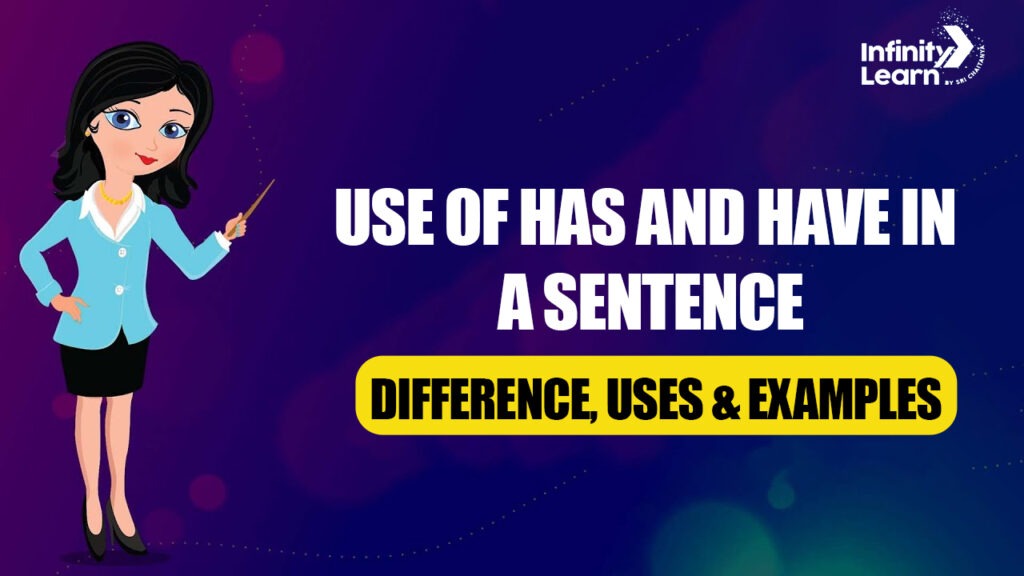Table of Contents
Use of Has and Have: Understanding the difference between ‘has’ and ‘have’ is important for using them correctly in sentences. Both words show possession or ownership, but they are used with different subjects. Let’s learn when to use ‘has’ or ‘have’ with simple examples.
Have you ever been confused about when to use ‘has’ and ‘have’ in a sentence? You’re not alone! Many people find these words tricky because they both show possession but are used in different situations. Understanding this difference is important for English grammar and helps you communicate clearly in English.
The correct use of ‘has’ and ‘have’ can change the meaning of a sentence. Using them incorrectly might confuse the reader. This is why learning when to use ‘has’ or ‘have’ is essential. In this article, we will explain their differences, explore their usage rules, and provide easy examples to help you understand them better. Let’s clear up this confusion once and for all!

Use of ‘Has’ and ‘Have’ in a Sentence
The words ‘has’ and ‘have’ are used to show possession, ownership, or experience in English grammar. The key difference is that ‘has’ is used with singular subjects (he, she, it), while ‘have’ is used with plural subjects (I, you, we, they).
For example, She has a beautiful dress (singular), but They have a big house (plural). These words are also used in negative sentences (He hasn’t finished his work) and questions (Have you seen this movie?). Understanding these basic rules makes it easier to use them correctly in everyday conversations!
Also Check: Prefix and Suffix
Difference Between ‘Has’ and ‘Have’
The words ‘has’ and ‘have’ both indicate possession or ownership, but they are used differently depending on the subject. The table below explains their differences, rules, and usage with examples.
| Aspect | Has 🟢 | Have 🔵 |
|---|---|---|
| Meaning | Used to show possession, ownership, or experience in the present tense. | Also shows possession, ownership, or experience, but used with different subjects. |
| Used With | – Singular subjects (He, She, It) – Singular nouns (A boy, The cat, My friend) |
– Plural subjects (I, You, We, They) – Plural nouns (Children, Dogs, Teachers) |
| Sentence Structure | Subject + has + object (He has a car.) |
Subject + have + object (They have a car.) |
| Examples (Singular) | – She has a new sandal. – The dog has a long tail. – Meena has an idea. |
– I have a Lunch box. – You have a great voice. 🎤 – My parents have a big house. |
| Examples (Plural) | ❌ (Not used with plural subjects) | – We have a meeting at 10 AM. ⏰ – They have three kittens. 🐱🐱🐱 |
| Negative Form | Has not (Hasn’t) (She hasn’t finished her homework.) ❌ |
Have not (Haven’t) (We haven’t seen that movie.) ❌ |
| Question Form | Has + Subject + Object? (Has she arrived?) |
Have + Subject + Object? (Have they eaten?) |
| With Helping Verbs | Used with ‘has been’ and ‘has done’ in present perfect tense. (She has been working all day.) |
Used with ‘have been’ and ‘have done’ in present perfect tense. (I have been waiting for an hour.) |
| With Modal Verbs (Can, Should, Must) | ❌ (Not used) | Always use ‘have’ with modals. (They must have left early.) |
Difference between Has and Have – Meanings

When to Use ‘Has’ and ‘Have’ in English Grammar?
The words ‘has’ and ‘have’ are commonly used in English grammar to show possession, ownership, or experience. However, knowing when to use ‘has’ or ‘have’ can be confusing for many learners. Let’s break it down in a simple and fresh way with clear rules and examples.
When to Use ‘Has’
Use ‘has’ with singular subjects in the third person (he, she, it, or singular nouns).
Examples of ‘Has’ in Sentences:
- She has a beautiful dress.
- The dog has a wagging tail.
- My brother has a new phone.
- It has been a long day.
Rule: Always use ‘has’ when talking about one person, thing, or animal.
When to Use ‘Have’
Use ‘have’ with plural subjects and with I, you, we, and they.
Examples of ‘Have’ in Sentences:
- I have a great idea!
- You have a kind heart.
- We have a big family.
- They have two dogs.
Rule: Use ‘have’ when talking about more than one person or thing or when using I, You, We, or They.
‘Has’ vs. ‘Have’ in Negative Sentences
When making negative sentences, add ‘not’ after has or have.
Examples:
- She has not (hasn’t) finished her homework.
- They have not (haven’t) arrived yet.
‘Has’ vs. ‘Have’ in Questions
To ask questions, start with has or have before the subject.
Examples:
- Has he eaten lunch?
- Have you seen this movie?
Special Cases: Has/Have with Helping Verbs
When used in the present perfect tense, ‘has’ and ‘have’ appear with been, done, seen, or written.
Examples:
- She has been to Paris.
- They have seen that show before.
Uses of ‘Has’ and ‘Have’ in Sentences
Negative Sentences
To make a negative sentence, use has not (hasn’t) or have not (haven’t) before the verb.
Examples:
- She has not (hasn’t) finished her homework.
- They have not (haven’t) seen this movie.
- I have not (haven’t) eaten breakfast today.
Interrogative Sentences (Questions)
To ask a question, place has or have before the subject.
Examples:
- Has he completed his project?
- Have you visited New York?
- Have they received their order?
Present Perfect Tense
In present perfect tense, ‘has’ and ‘have’ are used with helping verbs like been, done, seen, or written.
Examples:
- She has been to Paris.
- They have seen that movie before.
- He has written a great book.
Also check: Has and Have Worksheet
Contractions of ‘Has’ and ‘Have’
In spoken and informal English, ‘has’ and ‘have’ are often contracted (shortened) with pronouns.
| Full Form | Contraction | Example Sentence |
|---|---|---|
| Has not | Hasn’t | She hasn’t called today. |
| Have not | Haven’t | I haven’t finished my work. |
| He has | He’s | He’s been to the store. |
| She has | She’s | She’s got a new dress. |
| It has | It’s | It’s been a long day. |
| I have | I’ve | I’ve completed my homework. |
| You have | You’ve | You’ve done a great job! |
| We have | We’ve | We’ve visited that place before. |
| They have | They’ve | They’ve just arrived. |
Use of Has and Have: Practice Questions
1- Identify the correct sentence:
A) Each of the students have submitted their assignments.
B) Each of the students has submitted their assignments.
C) Each of the students has submitted his or her assignment.
D) Each of the students have submitted his or her assignment.
Answer: C) Each of the students has submitted his or her assignment.
Choose the correct option:
2- Neither of the players ____ arrived for the match yet.
A) has
B) have
C) has been
D) having
Answer: A) has
3- Identify the grammatically correct sentence:
A) The committee has decided on the new policy.
B) The committee have decided on the new policy.
C) The committee have been deciding on the new policy.
D) The committee having decided on the new policy.
Answer: A) The committee has decided on the new policy.
4- Which sentence is correct?
A) She and her brother has completed their homework.
B) She and her brother have completed their homework.
C) She and her brother having completed their homework.
D) She and her brother has been completed their homework.
Answer: B) She and her brother have completed their homework.
Select the correct option:
5- The results of the experiment ____ been analyzed carefully.
A) has
B) have
C) has to
D) has been
Answer: B) have
6- Choose the correct sentence:
A) The jury has reached a verdict.
B) The jury have reached a verdict.
C) The jury having reached a verdict.
D) The jury has been reached a verdict.
Answer: A) The jury has reached a verdict.
7- Find the grammatically correct sentence:
A) The number of students in the class have increased.
B) The number of students in the class has increased.
C) The number of students in the class having increased.
D) The number of students in the class has been increased.
Answer: B) The number of students in the class has increased.
Fill in the blank with the correct verb:
8- Every book on the shelf ____ its own unique cover.
A) has
B) have
C) having
D) has been
Answer: A) has
9- My father, along with his colleagues, ____ gone on a business trip.
A) has
B) have
C) had
D) having
Answer: A) has
10- Which of the following sentences is correct?
A) Neither of the candidates have responded.
B) Neither of the candidates has responded.
C) Neither of the candidates having responded.
D) Neither of the candidates has been responded.
Answer: B) Neither of the candidates has responded.
High-Level Fill in the Blanks Questions
Fill in the blanks with ‘has’ or ‘have’:
- The CEO, along with the board members, ____ approved the proposal. (has/have)
Answer: has - Many students in our class ____ participated in the debate competition. (has/have)
Answer: have - The police ____ arrested the suspect. (has/have)
Answer: have - My brother and I ____ decided to start a new project. (has/have)
Answer: have - Neither of my parents ____ ever traveled abroad. (has/have)
Answer: has - The jury ____ reached a final decision. (has/have)
Answer: has - Each of the books on the shelf ____ a unique story. (has/have)
Answer: has - The company ____ faced major financial losses. (has/have)
Answer: has - My grandmother ____ always been a great storyteller. (has/have)
Answer: has - The results of the experiments ____ been published in the journal. (has/have)
Answer: have
Use of Has and Have FAQs
Where do we use has and have?
Has is used with singular subjects (he, she, it, a single name). Have is used with plural subjects (I, you, we, they, multiple names).
Have is used for singular or plural?
Have is generally used with plural subjects (we, they, you). However, it is also used with the singular pronouns I and you.
When is have or has used?
Use has with singular third-person subjects (he, she, it). Use have with I, you, we, and they. In present perfect tense, have and has are used as auxiliary verbs (e.g., She has seen the movie, I have finished my work).
Do we use have or has with names?
A singular name takes has (e.g., John has a new car). Multiple names take have (e.g., John and Sarah have a dog).
Has or Have with a city name?
A city is a singular noun, so use has. Example: New York has a rich history.
Has or Have with brother?
Since brother is singular, use has. Example: My brother has a bicycle. If referring to multiple brothers, use have: My brothers have different hobbies.









